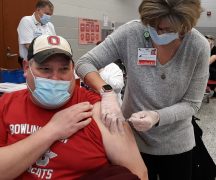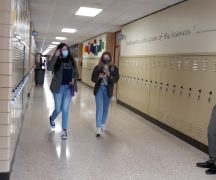By JAN LARSON McLAUGHLIN
BG Independent News
Measles were eradicated in the U.S. in 2000. Or so experts thought.
Nearly two decades later, the nation has seen an uptick in cases. But at least all those adults vaccinated in their youth are protected. Wrong again.
Recent national new stories initially focused on the need for parents to vaccinate their children against measles.
“We’ve grown up with a generation who doesn’t know how serious measles can be,” said Alex Aspacher, community outreach coordinator with the Wood County Health Department.
But after measles started showing up in vaccinated adults, another concern arose.
It appears that some adults who received the vaccine, which was created in the 1960s, may still be at risk because they only received one dose of the immunization – which was thought then to be adequate to ward off the disease. In other cases, some of the earlier vaccines given were not as potent as others. And physicians were not as accustomed in the 1960s to giving immunizations, so some did not follow the strict refrigeration rules – which then weakened the strength of the vaccines.
Many adults – given the shots in their very early years – don’t remember their immunization status and have no documentation. And the second dose of measles vaccine didn’t become standard until 1989.
So the Centers for Disease Control and Prevention is recommending that people who were born during or after 1957 who do not have evidence of immunity against measles should get at least one dose of MMR vaccine. And those adults with concerns and unsure that they received two measles vaccinations as children may want to get another immunization for additional protection from the disease.
“There is definitely something to be gained from the second shot,” Aspacher said. Blood tests are available to show the level of measles antibodies, but that costs about the same as an additional vaccine. And there is no harm in getting another vaccine, even if it is not necessary, Aspacher said.
According to the CDC, people vaccinated with two doses have a 97 percent chance at being protected against measles. If those people happen to come into contact with the virus, they’re less likely to spread it to others, and their illness is often milder.
Those people who received one dose have about a 93 percent chance of it preventing the disease.
Those people born before 1960 may have never been vaccinated against measles because it was assumed they had been exposed to the virus. The CDC states that most people born before 1957 don’t need the vaccine because before vaccines were available, nearly everyone was infected with measles, mumps, and rubella viruses during childhood.
“You probably had the measles and built immunities,” Aspacher said.
According to the Centers for Disease Control and Prevention, measles outbreaks in the U.S. can been blamed on the following two causes. First, there has been an increase in the number of travelers who get measles abroad and bring it into the U.S. And second, pockets of unvaccinated people have allowed the measles to spread.
In some recent years, there have been fewer than 100 cases nationwide. But measles has made a comeback this year – largely due to people spreading suspicion about vaccinations, experts say.
So far, 555 cases have been reported in 20 states. No cases have been reported in Ohio this year, Aspacher said.
The states that have reported cases to CDC are Arizona, California, Colorado, Connecticut, Florida, Georgia, Illinois, Indiana, Kentucky, Maryland, Massachusetts, Michigan, Missouri, Nevada, New Hampshire, New Jersey, New York, Oregon, Texas and Washington.
The vaccines are necessary to protect those unable to get the vaccine themselves – very young babies, the elderly, or some people with certain chronic illnesses.
“They rely on the rest of society being vaccinated to protect them,” Aspacher said.
“Vaccines are among the most successful and cost-effective public health tools for preventing disease and death. They help protect vaccinated individuals as well as entire communities by preventing and reducing the spread of infectious diseases,” Aspacher said.
Every year, people still die from the disease that the U.S. believed had been eliminated.
“Everybody should do their best to stop that,” he said.
Measles is still commonly transmitted in many parts of the world, including countries in Europe, Asia, the Pacific, and Africa, according to the CDC. An estimated 89,780 die each year from the disease.
Measles is a very contagious disease caused by a virus. It spreads through the air when an infected person coughs or sneezes. Measles starts with fever, then soon after it causes a cough, runny nose and red eyes. Then a rash of tiny, red spots breaks out. It starts at the head and spreads to the rest of the body.
Measles can be prevented with MMR vaccine. The vaccine protects against three diseases: measles, mumps, and rubella. CDC recommends children get two doses of MMR vaccine, starting with the first dose at 12 through 15 months of age, and the second dose at 4 through 6 years of age.
Before the measles vaccination program started in 1963, an estimated 3 to 4 million people got measles each year in the United States. Of those, approximately 500,000 cases were reported each year to CDC. Of those, 400 to 500 died, 48,000 were hospitalized, and 1,000 developed encephalitis (brain swelling) from measles.





